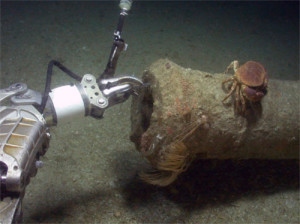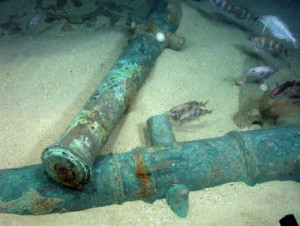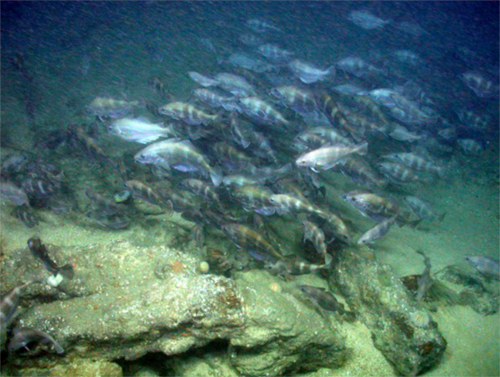News
Virtual Dive Trail Reveals Wreck of HMS Victory, unseen by the public for 269 years

Unseen by the public for 269 years, the greatest warship from the age of sail can now be visited through the world’s first virtual wreck dive trail. HMS Victory sank during a ferocious storm on 5 October 1744. Remains washed up on the Channel Isles, leading the Admiralty and modern historians to seek this First Rate English flagship off the Casquets. This great maritime mystery was solved when Odyssey Marine Exploration – a world leader in deep-sea archaeological research – discovered the wreck 100 kilometres west of the Channel Isles. The wreck site is owned by the Maritime Heritage Foundation following a gift from the Ministry of Defence in January 2012.
Located in the western English Channel, 80 kilometres southeast of Plymouth and outside UK territorial waters, the wreck of the Victory is almost inaccessible. Her remains lie in 75 metres – beyond safe diving depths and beneath one of the world’s busiest shipping lanes. Changing tides and strong currents make diving by humans dangerous. Offshore fishing boats drag heavy gear across the seabed. For safety reasons the surveys conducted since 2008 have relied on Odyssey’s 7-ton Remotely-Operated Vehicle Zeus, the world’s most sophisticated archaeologically tooled robot.
Now everyone can share the warship’s deep-sea wonders. The Victory Virtual Dive Trail presents high-definition video coverage. Visitors can move across the wreck – using a bird’s eye vertical view made up of 4,535 digital photographs – to micro views of the wreck and, in turn, to high- definition video taken in 2008.
The video trail shows many of the Victory’s most prized features – its 100 bronze cannon collapsed onto the seabed (including Europe’s most powerful 42-pounder guns), hull remains, wood and bronze rigging, iron ballast, anchors and the ship’s rudder. Accompanying text sets the archaeological remains in a historical setting.
The site’s survival is threatened by many environmental and human issues and the Virtual Dive Trail shows snagged fishing gear, heavily scratched cannon, and guns dragged up to 230 metres away from the wreck mound. Video captures the position of a 24-pounder bronze cannon before it was looted by Dutch salvors in 2011.
The Victory Virtual Dive Trail is part of the Maritime Heritage Foundation’s commitment to making this deep-sea site accessible to everyone through scientific and educational programmes. The UNESCO Convention on the Protection of the Underwater Cultural Heritage encourages non- intrusive access to shipwrecks worldwide to create public awareness, appreciation, protection and to benefit sustainable economic development. This is why a virtual dive trail has been created to bring the site to the people.
The Victory Virtual Dive Trail has been developed by the Maritime Heritage Foundation, Odyssey Marine Exploration and Wreck Watch Int. The website platform and its additional sections on the historical and archaeological background of HMS Victory can be visited at: www.victory1744.org.
About Victory (1744)
The direct predecessor to Admiral Nelson’s flagship bearing the same name, the First Rate HMS Victory commanded by Admiral Sir John Balchin was one of the most technically advanced ships in the world when she disappeared on 5 October 1744. Built with three decks and carrying up to 110 bronze cannon, she was the last British First Rate armed entirely with highly prestigious bronze guns. The Victory is the only archaeologically investigated First Rate English warship wreck discovered worldwide. Project Designs and Management Principles have been presented to HM Government seeking agreement to conduct a joint research and rescue oriented project on the wreck site, in the first instance to record and recover artefacts at immediate risk.
About the Maritime Heritage Foundation
The Maritime Heritage Foundation is a Charitable Trust established to locate, excavate, recover, raise, restore and/or preserve shipwrecks for the benefit of the United Kingdom. It was gifted the remains of the Victory by a deed of the Ministry of Defence in January 2012. Its Chairman, Lord Lingfield, is a relative of Admiral Sir John Balchin, who was the commander of the Victory when she sank in 1744. The Foundation’s Scientific Advisory Committee is directed by Dr. Margaret Rule, former director of the Mary Rose excavations and recovery.
About Odyssey Marine Exploration, Inc.
Odyssey Marine Exploration, Inc. (Nasdaq:OMEX) is engaged in deep-ocean exploration using innovative methods and state-of-the-art technology for historic shipwreck projects, modern commodity shipwreck projects and mineral exploration. Odyssey offers various ways to share in the excitement of deep-ocean exploration by making shipwrecks and artefacts available to the general public, students, and specialists through its virtual museum, exhibitions, loans to established museums, books, television and educational programme located at www.OdysseysVirtualMuseum.com. The company maintains a Facebook page at http://www.facebook.com/OdysseyMarine and a Twitter feed @OdysseyMarine. For additional details on Odyssey Marine Exploration, please visit www.shipwreck.net.
About Wreck Watch Int.
Wreck Watch Int. is a London-based consultancy specializing in global maritime heritage. With a booming demography and coastal development, marine construction, fisheries, sport divers, shipwreck explorers, looters and the cutting of oil pipelines and cable lines are exerting ever- increasing pressures on shorelines and offshore waters. Directed by Dr. Sean Kingsley, Wreck Watch casts a spotlight on the threats to shipwrecks in deep and shallow waters and on submerged harbours. A central objective is to bridge academic research, the private sector, industry and the general public for purposes of mainstream education, understanding and entertainment and to make the underwater world a demystified, non-exclusive realm accessible to all. For additional details on Wreck Watch Int., please visit www.wreckwatch.com and blog.wreckwatch.com.
News
Book Review: Fire on Monroe Bravo by Fred Lockwood

Fire on Monroe Bravo is the latest book in the Jack Collier series by Fred Lockwood. Our story begins with our lead characters, Jack and Sandro, owners of Marine Salvage & Investigation Company, arriving on the Monroe Bravo Oil & Gas Platform in the North Sea. Having secured a contract for their vessel the MV Stavanger to act as support ship to the platform for TransGlobal Oil, our protagonists are on a celebratory visit.
However almost as soon as they arrive a series of explosions rock the platform, causing huge damage, loss of life and the very real danger of a massive human, ecological and financial disaster.

As the danger mounts for both our heroes and the surviving workers, Jack and Sandro will have to escape the inferno, all while trying to save the platform and the men still trapped unable to help themselves.
The disaster sets the scene for the unfolding story lines following the fate of the platform and our main characters, the police investigation into a suspected terrorist act and the actions of TransGlobal Oil as they attempt to navigate the pubic outcry and financial repercussions.
In his eighth book, Fire on Monroe Bravo, Fred Lockwood delivers an explosive thriller, with plenty of above and in-water drama, and our heroes fighting for survival, what more can you ask for?
We thoroughly recommend this read and look forward to the next in the series. For more information about his book series, you can check out the reviews of his previous books here on Scubaverse.
- Title: Fire On Monroe Bravo
- Author: Fred Lockwood
- ISBN: 979-8325324536
Available in a paperback version and for Kindle from Amazon and book stores.
Blogs
Alonissos: The complete diving destination (Part 1)

In June we were incredibly fortunate to be invited to dive in Alonissos, a small Greek Island in the Sporades island chain located in the North Aegean Sea. While I have long been a big fan of the Greek Islands as a great holiday destination, I had not had the opportunity to do any diving on previous visits and Mike and I were extremely excited to see what Alonissos had to offer both above and below the surface!

The Sporades are easily accessible via the airport in Skiathos (the first island in the chain), which is served by Jet2 flights from all major UK airports from May through October. Numerous ferries and charter boats make island hopping from Skiathos Town a breeze. After an hour boat ride, the picturesque port of Patitiri was a wonderful introduction to Alonissos, where we were met by our gracious hosts Kostas of Albedo Travel and Dias of Alonissos Triton Dive Center. Mike and I were delighted to be staying at the Paradise Hotel, aptly named for its stunning views over the sea and great location for walking to the waterfront.

Alonissos is beautifully situated in the National Marine Park of Alonissos and the Northern Sporades, the largest marine protected area in Europe. The surrounding seas offer fabulous marine life, including incredibly rare species such as the Mediterranean monk seal. They boast deep walls covered in gorgonians and sponges, stunning topography with caverns, swimthroughs and pinnacles, and the first accessible ancient shipwreck from 500BC!

In locations where historical sites have been reported, the waters are largely restricted, but with collaboration between government, underwater archeologists and dive centres, incredible underwater museums are being created for a truly unique diving experience. Alonissos is home to the first of these, the Ancient Shipwreck of Peristera Accessible Underwater Archeological Site. The chance to dive into history (along with reports of healthy reef life and amazing underwater topography) meant Mike and I were keen to get in the water.

Our introduction to the diving around Alonissos was at the Agios Georgios Pinnacles, in the channel between Alonissos and Skopelos. This fantastic site was named “The Chimney,’ and proved to have a huge amount to see. We got to a decent depth here (over 25m), and marvelled at a colourful reef wall with a wonderful swim through whose rocky walls were absolutely covered with life. As well as brilliant topography there was no shortage of macro life here. We saw numerous nudibranchs, five different species in total. The second dive at Mourtias reef nearby was a shallower dive along a nice wall with lots of crevices. Several moray eels and grouper called this site home. We enjoyed looking in the crevices for lobster and smaller benthic life, such as cup corals and tunicates.

Our itinerary allowed us two dives a day with afternoons left to explore the island with our hire car and evenings to enjoy the famous Greek hospitality. This proved to be a lovely mix of in-water and land based diversions.

The next days diving to the Gorgonian Gardens and Triton’s Cave was to be even better! These two stunning sites are nothing short of fabulous. The Gorgonian Gardens was a deep wall near to the Agios Georgios islands. The ever-present currents in this deep channel meant that the sea life was amazing … the namesake Gorgonian sea fans dotted the wall at a depth of 30 to 50 meters, getting ever larger the deeper we went. Above 30m was by no means less beautiful, with sponges, corals, scorpionfish, moray eels and some rare and colourful nudibranchs.

The second shallower dive of the day was to Triton’s Cave or the Cavern of Skopelos, on the east side of that island. The spectacular rock formations had wild striations both above and below the water making a truly epic topography. The cavern entrance was at 14m, and big enough for a buddy pair, winding up to 6m and passing two beautiful windows out into the blue. Emerging from the cavern, the light at the shallower depths and the incredible rock formations made for a fantastic gentle swimming safety stop and we all surfaced by the boat with massive grins.

Check out our next blog :Alonissos: The complete diving destination (Part 2)” to hear about our amazing dive on the 2500 year old Peristera Wreck!
Thanks to:
Alonissos Triton Dive Center https://bestdivingingreece.com/
Albedo Travel https://alonissosholidays.com/activities/
Paradise Hotel https://paradise-hotel.gr/
Alonissos Municipality https://alonissos.gr/en/
-

 Blogs2 months ago
Blogs2 months agoDiving With… Nico, Ocean Earth Travels, Indonesia
-

 News1 month ago
News1 month agoMurex Bangka Announce New Oceanfront Cottages & Beachfront Dining
-

 Blogs2 months ago
Blogs2 months agoA new idea in freediving from RAID
-

 Marine Life & Conservation1 month ago
Marine Life & Conservation1 month agoIceland issue millionaire whale hunter a licence to murder 128 vulnerable fin whales
-

 Marine Life & Conservation2 months ago
Marine Life & Conservation2 months agoThe Shark Trust Great Shark Snapshot is back
-

 News3 months ago
News3 months agoCharting New Waters; NovoScuba Goes Global with the Launch of their Revolutionary Dive Training Agency!
-

 Gear News1 month ago
Gear News1 month agoNew Suunto Ocean – a dive computer and GPS sports watch in one for adventures below and above the surface
-

 Marine Life & Conservation Blogs2 months ago
Marine Life & Conservation Blogs2 months agoBook Review: Plankton









